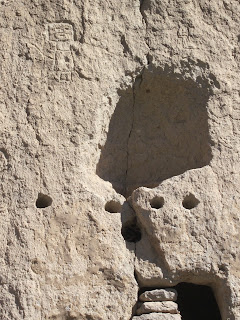Winding through the canyons near Los Alamos and seeing the steep cliffs pocked with holes should have been an indication of the wonder that awaits at Bandolier National Monument to me, but I was so inspired by the beauty of the surroundings they did not register. A short distance from the visitor’s center at the monument, the canyon cliff walls rise precipitously, and in them are many, many caves and dwellings from centuries ago. Since I was little, I have always loved going to places and seeing how peoples there lived before modern times. In these past years, I have had the good fortune to see monuments and sites in the Americas. What I am struck by in these locales, be they in Peru, Mexico, or New Mexico, is the rootedness in place they exhibit with the materials and configuration of the settlement patterns. I have never visited any settlements that were based on the circle as the abandoned pueblo at Bandolier and the thriving pueblo at Taos are. There’s something powerful to me about basing the town pattern on a sacred geometric form. I am no expert, but it’s a compelling way to connect people to the land and to their ancestry. Besides, it’s also very defensible against marauders. The cave dwellings were beautiful and interesting as spaces, and the prospects they offered of the verdant valley were inspiring and at the same time comforting. I enjoyed the adventure of climbing into them and imagining what the scene must have been like centuries ago.
Perhaps the most exciting experience of going to Bandolier was seeing the petroglyphs in the canyon walls above former dwellings. There were many incised circles, spirals, people figures, and abstract step patterns. My favorite one was of a parrot. At 100 paces and after centuries, this rendering had a divine sense of humor, spirit and gesture. I love when art makes me laugh. Seeing this art, in this setting, and how the connection it shared with patterns of settlement and belief was marvelous. As an artist, it inspired me greatly to see that the compulsion to make stuff, to express wonder or confusion or just joy, spans time, cultures and place. It’s a gift for today, the future and the ones who went before.







No comments:
Post a Comment